Paper-based trays offer an eco-friendly alternative to plastic trays by being biodegradable and compostable, reducing environmental impact. Your choice of paper trays supports sustainable practices without compromising on functionality or durability.
Table of Comparison
| Feature | Paper-Based Tray | Plastic Tray |
|---|---|---|
| Material | Renewable paper pulp | Petroleum-based plastic (PET, PP) |
| Environmental Impact | Biodegradable, compostable, recyclable | Non-biodegradable, limited recyclability |
| Weight | Lightweight, reduces shipping costs | Generally heavier |
| Durability | Moderate, susceptible to moisture | High, water-resistant |
| Cost | Generally lower cost | Higher cost due to material and manufacturing |
| Use Cases | Food packaging, eco-friendly brands | Long shelf life products, moisture-sensitive goods |
| Customization | Printable, adaptable shapes | High precision moulding options |
| Recycling Infrastructure | Widely accepted in paper recycling streams | Requires specialized plastic recycling facilities |
Introduction to Packaging Trays
Packaging trays serve as essential components in product presentation and protection, with paper-based trays offering eco-friendly, biodegradable alternatives to traditional plastic trays. Paper trays provide excellent customization options for branding and are ideal for sustainable packaging solutions, reducing environmental impact through recyclability. Your choice between paper-based and plastic trays should consider factors like product durability, cost-effectiveness, and environmental goals.
Material Composition: Paper-Based vs Plastic
Paper-based trays are primarily composed of renewable fibers such as recycled paper pulp, which makes them biodegradable and eco-friendly compared to plastic trays made from petroleum-derived polymers like polyethylene or polypropylene. Plastic trays offer superior durability, moisture resistance, and structural integrity but pose environmental challenges due to their slow decomposition and potential for pollution. Choosing paper-based trays supports sustainability initiatives by reducing reliance on fossil fuels and promoting compostable packaging solutions that minimize landfill waste.
Environmental Impact Comparison
Paper-based trays significantly reduce environmental impact compared to plastic trays due to their biodegradability and compostability, which minimize landfill accumulation. The production of paper trays typically consumes less fossil fuel and generates lower greenhouse gas emissions than plastic manufacturing processes that rely heavily on petroleum. Recycling and disposal of paper trays contribute to a smaller carbon footprint, promoting sustainable packaging solutions aligned with circular economy principles.
Cost Analysis: Paper vs Plastic Trays
Paper-based trays generally offer a lower upfront cost compared to plastic trays, making them an economical choice for short-term or single-use applications. Plastic trays, although more expensive initially, tend to provide better durability and reusability, which can reduce replacement expenses and offer long-term cost savings. Evaluating your specific usage frequency and sustainability goals will help determine whether the cost benefits of paper or plastic trays align better with your budget.
Durability and Strength Factors
Paper-based trays offer limited durability and strength compared to plastic trays, as they are prone to bending, tearing, and moisture damage under heavy loads or wet conditions. Plastic trays provide superior structural integrity, resisting impact, moisture, and repeated use, making them ideal for long-term storage and transportation. The material composition of plastic trays, typically high-density polyethylene (HDPE) or polypropylene (PP), enhances their durability and load-bearing capacity beyond the capabilities of paper-based alternatives.
Food Safety and Hygiene Considerations
Paper-based trays are often favored for their biodegradability and reduced chemical leaching compared to plastic trays, contributing to safer food contact surfaces. Plastic trays can harbor bacterial growth in scratches and are prone to chemical migration when exposed to heat, posing potential food safety risks. Ensuring proper sanitation and selecting trays that comply with food safety standards is essential for both materials to maintain optimal hygiene.
Consumer Perception and Preferences
Consumers increasingly perceive paper-based trays as more environmentally friendly and sustainable compared to plastic trays, valuing biodegradability and recyclability. Preference trends indicate a growing demand for paper trays in food packaging due to concerns over plastic pollution and health safety. However, some consumers still favor plastic trays for their durability and moisture resistance, highlighting the trade-off between eco-consciousness and functionality.
Recyclability and End-of-Life Options
Paper-based trays offer superior recyclability due to their biodegradable properties and compatibility with most curbside recycling programs, making them an environmentally friendly choice at the end of their life cycle. Plastic trays, while durable, often face challenges in recycling because of contamination and limited facilities that accept certain plastic types, leading many to end up in landfills. Choosing paper-based trays can enhance your sustainability efforts by ensuring easier disposal and a reduced environmental footprint.
Industry Trends and Innovations
Industry trends reveal a growing shift towards sustainable packaging, with paper-based trays gaining traction due to their biodegradability and recyclability compared to conventional plastic trays. Innovations in paper-based materials now enhance durability and moisture resistance, making them viable for diverse applications in food and retail sectors. Your choice of packaging aligns with eco-conscious consumer demand, driving brand reputation and compliance with emerging environmental regulations.
Choosing the Right Tray for Your Needs
Selecting the right tray depends on factors like environmental impact, durability, and cost-effectiveness. Paper-based trays offer biodegradability and sustainability, making them ideal for eco-conscious businesses and short-term use. Plastic trays provide superior strength and longevity, suitable for heavy-duty applications and reusable purposes.
Paper-based tray vs plastic tray Infographic

 libmatt.com
libmatt.com